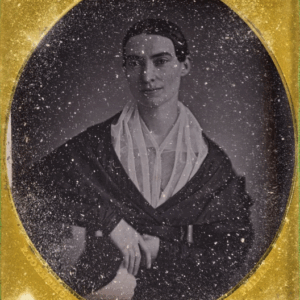JTF (just the facts): A total of 9 color photographic works, generally framed in white and unmatted, and hung against white walls in the single room gallery space. 6 of the works are archival inkjet prints, made in 2018 or 2015/2018. Physical sizes range from 8×24 to 28×42 inches, and these prints are available in editions of 5+2AP.
The other three works on view add additional elements to the archival inkjet print base. One consists of archival inkjet prints on aluminum with wood (sapele) and brass wire, made in 2018; it is 31×31 inches and is unique. The second is an installation of a lightbox print, painted aluminum, and willow branches, made in 2018; its dimensions are variable and it is unique. The last consists of an archival inkjet print, acrylic, and vinyl, made in 2018; it is sized 28×42 inches and is available in an edition of 3+2AP. (Installation shots below.)
Comments/Context: A photograph made straight on – whether a portrait, a landscape, or some other genre – must inevitably deal with a sense of obviousness. When the photographer strips away distraction and forces the viewer to look closely at the subject, much of its uncertainty and mystery can be lost, which is, of course, the point. The person, place, or thing is what it is, and the photograph confirms and documents that version of reality.
Elliott Jerome Brown Jr.’s recent photographs explore a more elusive side of portraiture, where sitters are obscured as often as they are shown and the resulting photographs refuse to resolve into neat conclusions. He is testing the edges of open-ended portrait making, deliberately leaving situations undescribed and questions unanswered.
The artist’s grandparents seem like the kind of conventional subjects that would naturally fall toward poses and patterns we have seen before. But Brown upends those expectations by interrupting the two images with foreground elements and using mirrors to reorient the reflections. An ornate iron railing and the back of a metal chair disrupt our view of grandma and grandpa respectively, each one given a note of dissonance by the compositional tool.
Other portraits turn the subjects away or employ angles that keep us from seeing the sitters’ faces, giving us few clues to generate clear narratives. One woman is seen from behind, her mass of dark hair turned into a textural blur. In another picture, the only identifying detail of the subject is a pair of sparkly DG sunglasses that peek out over an edge of ornately patterned fabric (perhaps an elbow and hip) – stars on the wall behind are seen crisply, but the situation is otherwise uncertain.
Brown goes further with this approach when he introduces other physical objects into the compositional structure. In one work, an old time wooden template used to arrange pictures in a frame is repurposed by the artist, the physical emptiness of the circles and squares showing fragments of Brown’s own portraits underneath. The combination makes Brown’s overlapped images (which are dominated by legs, feet, and bodies turned away) even more abstract, fragmented, and misaligned, the whole feeling like a puzzle with many missing pieces.
The largest work on view in the show is more like an installation than a discrete photograph, although a print on a lightbox is the central part of the experience. Brown captures a man lifting a sofa from an underneath angle, showing us just his legs and the underside of the couch. This image is then installed behind a dappled screen of metal rods and woven willow branches leaning against the wall, further obscuring the scene. The combination creates a double layer of interruption, the subject blocked by both the sofa and the binary open/closed effect of the gallery install.
Brown is still early in his photographic career, but these aesthetic ideas, especially as he has applied them to the African-American experience, certainly show promise. In his hands, ambiguity offers an opportunity for depth and richness, where alternate perspectives and readings are embedded in the intimacy of a single image.
Collector’s POV: The works in this show range in price from $2000 to $15000. Brown’s work has little secondary market history at this point, so gallery retail remains the best option for those collectors interested in following up









